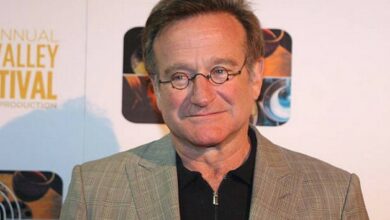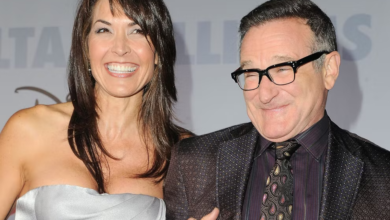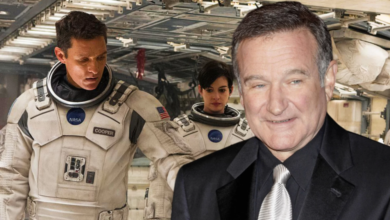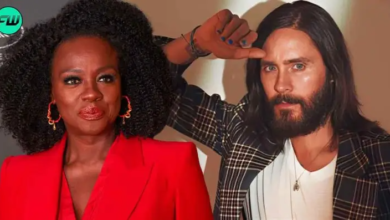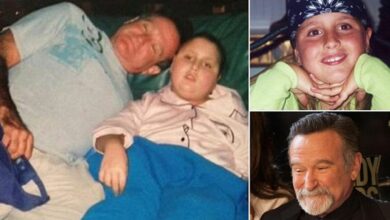The 1983 Stand-Up Special That Proved Robin Williams Had Staying Power
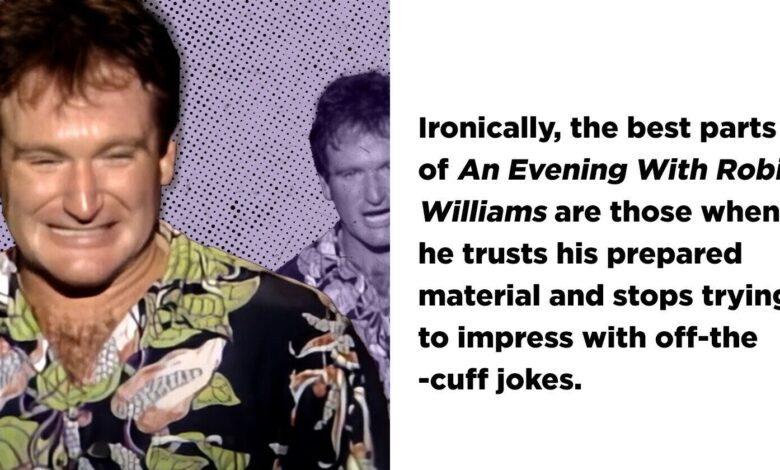
1983 was a weird time to be Robin Williams. Just six years earlier, he’d exploded into the national consciousness with Mork & Mindy, a sitcom that, at least initially, played to his strengths as a manic oddball able to riff stream-of-consciousness one-liners at breakneck speed. He’d gone from unknown comic to cosmic superstar in a matter of months. But it was fair to ask: Would Williams’ descent back to Earth be just as swift?
Mork, which debuted in 1978 as the third-most-watched show on television when that meant something, ended its run in free-fall: #27 in Season Two, #49 in Season Three and #60 in its final Season Four. On the heels of that, what must have seemed like Williams’ dream job, playing the cartoonish Popeye for Robert freaking Altman opposite Shelley Duvall in 1980, turned out to be a fiasco.
So there was a lot riding on An Evening with Robin Williams, an HBO comedy special featuring material that would also make up his second comedy album, Throbbing Python of Love. He had returned to his adopted home of San Francisco to prove that the hometown boy could still make good.
Fair to say, he made good. An Evening with Robin Williams doesn’t age as well as the specials of some of his contemporaries, but this exhaustive, exhausting performance still impresses. Love Williams or hate him, you can’t say the guy doesn’t come to play. You like crowd work? Williams is more of a stage diver. In fact, his interactions with the audience are borderline aggressive, bursting into the crowd to insult people’s outfits, screw with the camera operators and tweak unsuspecting men’s nipples. It’s a good nine minutes into the special before Williams finds his way back onto the stage to begin his “prepared material,” though he gives the illusion of making it all up on the spot.
(I saw Williams live in 2002, and the act had matured a great deal by then. Less frantic “look at this show-biz reference that I pulled out of my ass!” and more prepared material that still played to his ability to seamlessly transform into multiple characters. But I digress.)
The crowd clearly loves Williams’ forays into their territory, even when the heavily perspiring comic insists on trying on their coats and jackets. A woman who leaves for the restroom becomes the subject of a five-minute gag, with Williams pretending to be a police officer navigating a hostage situation. He steals another tourist’s expensive-looking camera and does an extended riff, sticking it inside his Hefty-bag trousers to take a picture of Mr. Happy with “the wide-angle lens.”
If the special has a co-star, it’s Mr. Happy, just one of Williams’ nicknames for his penis. Like a toddler who hasn’t yet been socialized to keep his hands where we can see them, 1983 Williams had a penchant for cradling his crotch — as a punchline, as a sight gag, as an exclamation point. His genitalia doesn’t only have a mind of its own, it has a voice of its own, carrying on extended conversations with its owner and reminding all of us who’s really running the show.
Pop Goes the Culture
One of Williams’ comic superpowers is his ability to pull pop-culture references from the sky to pepper his improvisations. But those bits are also his kryptonite. Williams fans know that the comedian will inevitably go to this familiar well, breaking into the Wicked Witch of the West’s “help me!” or Truman Capote’s lisp so often that references that once seemed clever risked becoming cliches.
Williams had a virtual in-house repertory company with characters that he slips into with ease — Dumb Southerner, Gnarly Californian, Squeaky-Voiced Kid, Hunchback of Notre Dame, Arnold Schwarzenegger and Jack Nicholson. If he were performing today, I’m guessing two of his most prominent impersonations would go by the wayside: an effeminate, limp-wristed character who shows up as both hairdresser and choreographer, and a Black man who can be a) from Oakland; b) Mean Joe Greene; or c) anyone who wants to threaten Williams’ “honky ass.” These haven’t aged well.
But unlike the comedians that came immediately before him (George Carlin, Richard Pryor) and immediately after (Stephen Wright, Jerry Seinfeld), Williams’ insistence on being topical will likely make parts of An Evening with Robin Williams a head-scratcher for anyone younger than Gen X. Here’s a short list of his pop-culture callouts during this particular show:
- Slim Whitman
- Quest for Fire
- Fotomats
- Amway
- Sony Walkman
- Falkland Islands
- Alexander Haig
- The pig squeal and banjo from Deliverance
- Wild Kingdom and its host, Marlin Perkins
- Carl Sagan
- Hare Krishna
- Bo Derek
- The National Enquirer
The audience gleefully laughs in recognition of those dated connections, but they won’t resonate today. The same goes for the drug and alcohol references — still fair subject matter for comedy, but the mere mention of cocaine in 1984 apparently worked as a punchline. Blame Willaims, at least partly, for the hacky trope of describing anything remotely strange as “(blank) on acid.” Big laughs every time he does it here.
What a Character
Ironically, the best parts of An Evening with Robin Williams are those when he trusts his prepared material and stops trying to impress with off-the-cuff jokes. Two moments in particular, both occurring late in the show, resonate.
The first is his announcement that he’s about to become a father, a moment of humanity that seems to have real meaning for Williams. He takes us through his unborn son’s imagined life, beginning with “Christopher’s” birth (“Men — we spend nine months trying to get out the womb, and the rest of our lives trying to get right back in”). As a boy, Christopher is the spoiled offspring of a celebrity, more interested in trust funds and power of attorney than his dad’s comedy. At 21, he’s a brat no longer but still refusing to follow in his father’s funny footsteps, choosing to be a scientist (“to cure herpes”) instead. Then when Williams ages into an impoverished old man, unable to care for himself, it’s Christopher who brings him back home. The boy grabs his own crotch to prove the old man taught him something after all.
It’s a touching bit, riding that razor’s edge between the treacly sentimentality of Patch Adams and the genuine poignancy of Good Will Hunting.
Williams ends the show with a run about a newsboy (newsman?), hawking his papers with a loud “Read all about it!” even though I’m pretty sure newsboys hadn’t been around since the 1920s. The slightly off-his-rocker character cracks wise for a bit (“Did you drill Pam Dawber? I didn’t think so.”) before offering Williams a genuine Albert Einstein autograph, a treasure Williams owned in real life. It’s a reminder for Williams to hold tight to his sense of wonder about the universe. The scene is affecting and, for some reason, reprised after the live show as a split-screen interaction between Williams and Williams sans audience. Skip the second iteration and you won’t miss much.
An Evening with Robin Williams is a fascinating piece of history, capturing the comedian when his most remarkable talent was stand-up comedy. His “John Davidson sings Devo” still holds up, as does his killer Elmer Fudd performing the hits of Bruce Springsteen. This special arrived at a tenuous time, years before Good Morning, Vietnam, Dead Poets’ Society or Mrs. Doubtfire made him undeniable. Coming off Popeye and Mork, we see a Robin Williams who is singing for his supper, convincing us that he has the goods to make it for the long haul.

